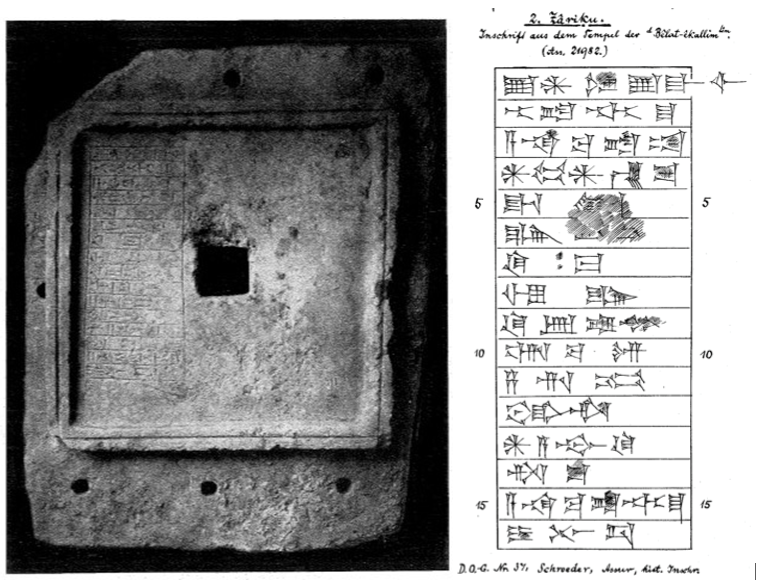Zarriqum
Zarriqum held the highest office in the city of Aššur, the position of šakkanakku (governor), for an uncertain length of time during the period of hegemony of the Third Dynasty of Ur [http://cdli.ox.ac.uk/wiki/doku.php?id=dynasties_of_sargon_ur-baba_and_ur-nammu] (ca. 2112-2004 BCE; see below). The exact nature of his office -- whether he was a governor subservient to Ur or an independent ruler -- and the history of his career are still matters for debate among scholars.
A first question is the actual extent of Ur III state's boundaries and whether they included Aššur as a province or if the Assyrian city remained an independent entity. Until the 1950s, it was generally accepted that already by the time of Ur-Namma (2112-2095 BCE) the Ur state controlled numerous polities as far as the Mediterranean coast, including Ebla and Byblos. By the 1970s, scholars had come to believe that the size of the Ur's sphere of influence was considerably smaller; D.O. Edzard and G. Farber (1974) proposed that only Babylonia, Diyala, and Susiana were the regions directly under Ur's control, while more recent studies on the Ur III taxation system (Steinkeller 1987; Scharlach 2004) suggest that the state's core was constituted of nineteen provinces stretching from the Persian Gulf to Sippar in the north and Susa in the east. Aššur seems to have fallen outside the provincial system (see Michalowski 2009, 150 n. 1, and Scharlach 2004, 6-7). For example, P. Michalowski (2009, 153) argues (on the basis of his evaluation of Zarriqum's career, see below) that Aššur was an independent vassal state beyond the reach of the direct control of Ur. W. Sallaberger (2007, 434), K.R. Veenhof and J. Eidem (2008, 19 n. 4), and G. Barjamovic (2011, 4 n. 15), however, believe that Aššur was "the northernmost province of the Ur empire with well-known governor Zarriqum" (Sallaberger, 2007).
Apart from the stone plaque from Aššur published here, the name of Zar(r)iq(um) appears in a number of contemporary sources from Drehem/Puzriš-Dagān, Umma, and Girsu, and from every possible social class from slave to governor; the available textual evidence has caused some disagreement in the studies related to the career of the šakkanakku of Aššur. Following one popular early proposal (Hallo 1956), Zarriqum began as an official (nu-bànada/captain; Kutscher 1979, 81-82) under the rule of Šulgi [http://cdli.ox.ac.uk/wiki/doku.php?id=biography_shulgi] (2094-2047 BCE), then became the governor of Aššur, and finally, during the reign of Amar-Suena [http://cdli.ox.ac.uk/wiki/doku.php?id=amar-suen] (2046-2038 BCE), the governor of Susa. However, dated documents from Umma and Puzriš-Dagān seem to prove that the three namesakes in those corpora were in fact three different individuals, and not one and the same man (see Rudik 2017 for detailed sources and earlier scholarly literature).
The Zarriqum who was the man in charge at Aššur is attested by different texts and titles, always in a subordinate relationship to the Ur III rulers (Rudik 2017). Texts from Puzriš-Dagān attest his tenure in office from Šulgi Year 44 [http://cdli.ox.ac.uk/wiki/doku.php?id=year_names_shulgi] (2050 BCE) to Amar-Suena Year 5 [http://cdli.ox.ac.uk/wiki/doku.php?id=amar-suen_year-names] (2042 BCE). In the stone plaque inscription from Aššur edited here, which was discovered in the ruins of Old Assyrian temple of Ištar, Zarriqum's title šagina or šakkanakku ("general, military governor") and "servant of Aram-Suena," is seen by many scholars as evidence that Aššur was a province of Ur at that time. The absence of Zarriqum's name from the Assyrian King List [http://oracc.museum.upenn.edu/riao/kinglists/assyriankinglist/index.html#First2chronological] (which appears to include only independent rulers) seems to confirm Aššur's state of vassalage during this period. However, Michalowski (2009) believes that the Zarriqum attestations in Puzriš-dagān's texts as awēl Aššur confirm that this man was an independent ruler of a foreign state and that the title of šakkanakku should be considered a royal title, just as it was at Mari and in other cities in northern Mesopotamia and Syria (ibid. 152-154). Furthermore, Michalowski suggests (ibid. 152) that when Zarriqum dedicated the temple of Ištar at Aššur to Amar-Suena he was acting as an independent vassal (to prove his loyalty) and that he made an official visit to an (unspecified) city in the heart of the Ur III state (to swear an oath of allegiance); a similar oath-swearing ceremony was performed at Nippur few years later (Šu-Suena 3 [http://cdli.ox.ac.uk/wiki/doku.php?id=year_names_shu-suen]) by the independent king of Nineveh, Tiš-atal (Whiting 1976, 177-178; Steinkeller 2007).
Bibliography
Browse the RIAo Corpus [http://oracc.museum.upenn.edu/riao/pager/]
2001
An inscription of Zarriqum, governor of the city Aššur, records that he (re)built the temple of the goddess Bēlat-ēkallim on behalf of his overlord, the Ur III king Amar-Suena (2046-2038 BC, according to Brinkman's chronology). The text is written on a stone plaque and was discovered in the altar room of the Old Assyrian Ištar temple at Aššur; the object is now in Istanbul (Eski Șark Eserleri Müzesi of the Arkeoloji Müzeleri).

Andrae, AIT pl. 64c; Schroeder, KAH 2 no. 2
Access the composite text [http://oracc.museum.upenn.edu/riao/Q001801/] of Zarriqum 2001.
Bibliography
Nathan Morello
Nathan Morello, 'Zarriqum', The Royal Inscriptions of Assyria online (RIAo) Project, The RIAo Project, a sub-project of MOCCI, 2021 [http://oracc.museum.upenn.edu/riao/fromcolonytocitystate23341809bc/sargonicanduriiiperiods/zarriqum/]